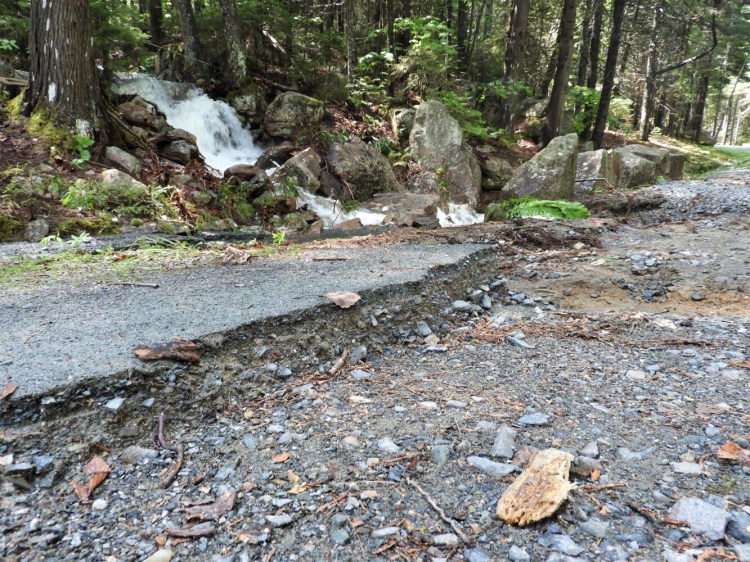It could take up to two months for the National Park Service to stabilize and repair Acadia National Park’s historic carriage road system after about 10 miles of it were heavily damaged during a torrential rainstorm last week.

The storm, which overwhelmed the carriage road system’s culverts and drainage systems, damaged carriage roads in the western section of the park near Jordan Pond, Sargent Mountain and Parkman Mountain. Park officials said the torrential rains blasted off three layers of road cover at several locations.
“Thousands of visitors enjoy the carriage roads every day of the summer, and we recognize the importance of opening them as soon as possible,” Acadia park Superintendent Kevin Schneider said. “We will seek emergency funds and use emergency contracting procedures to repair the damage within the next few months.”
Acadia’s carriage road system is a beloved network of trails through forests, past fields and ponds and along the sides of mountains used by bicyclists, pedestrians and equestrians.
Schneider said the carriage roads were built between 1913 and 1940 and were engineered to withstand heavy rain. The roads consist of three layers of crushed rock, and stone culverts and deep ditches provide channels to direct runoff away from the gravel surface.
In addition to closing the newly damaged portions, the park service had closed a 6-mile stretch of carriage roads that loop around Eagle Lake – part of an ongoing improvement project expected to be completed by mid-September. As the park heads into its busy summer season, only 29 miles of its 45-mile carriage road system will be open to the public.
“The storm damage certainly adds another twist to what is shaping up to be a complex situation,” said David MacDonald, president of the Friends of Acadia, referring to the Eagle Lake loop repairs on top of restrictions on park usage caused by the COVID-19 pandemic. “The carriage roads are a little less of a headliner than Thunder Hole or Cadillac Mountain, but they play a very valuable role in supporting the dynamics of the park.”
MacDonald said he heard reports of streams overflowing their banks and a wall of water cascading down the side of Sargent Mountain during the storm.
“A storm like this defied the norm,” he said.
MacDonald said he still expects a huge influx of visitors to Acadia this summer because of pent up demand to enjoy the outdoors now that the pandemic appears to be easing.
“I don’t believe the closures will drive visitations down,” MacDonald said. “We’re already seeing a lot of folks who have come here from out of state. We are just asking everyone to plan ahead and to be patient. The great thing about Acadia is there are a lot of (recreation) options.”
Jay Elhard, a ranger at Acadia, agreed.
“There are still lots of carriage roads and hiking trails to explore,” Elhard said.
The rainstorm peaked between 4:30 and 7:30 a.m. on June 9. During that time, Jordan Pond received 2.5 inches of rain and 4.7 inches was recorded at Cadillac Mountain’s summit. The U.S. Geological Survey stream gauge at Otter Creek reached a water level of almost 10 feet, an increase of 8.5 feet from the week before.
The June 9 storm dumped about 5 inches of rain on Bar Harbor and Acadia National Park, according to Tim Duda, a meteorologist with the National Weather Service in Caribou. Duda said the entire region to the east of Acadia got drenched that day, including most of Hancock and Washington counties.
“The short duration and intensity of the rainstorm makes it one of the most exceptional weather events in the park’s history,” Acadia National Park said in a statement.
Carriage roads were not the only areas hit hard by the storm, according to park officials. The Wild Gardens of Acadia at Sieur de Monts, the Schoodic bike paths, and Schoodic Head Road have also been closed because of storm damage. The Schoodic bike paths include more than eight miles of bicycling trails in Gouldsboro and Winter Harbor.
Hiking trails in Acadia National Park remain open, but certain sections, including foot bridges, may be washed out. Hikers should use caution and avoid crossing damaged sections.
The Associated Press contributed to this report.
Send questions/comments to the editors.


